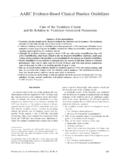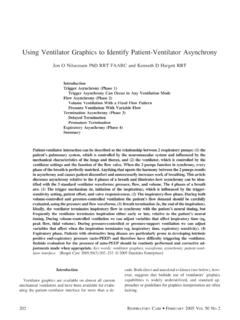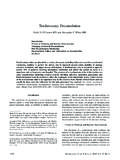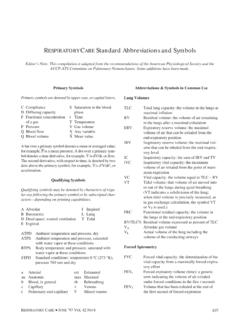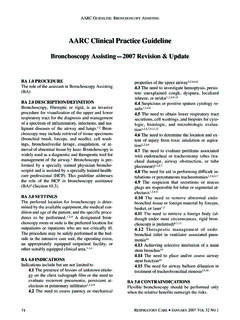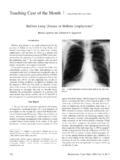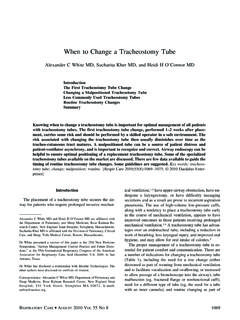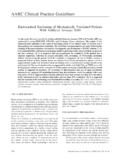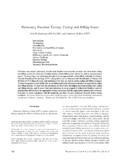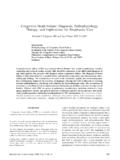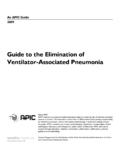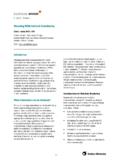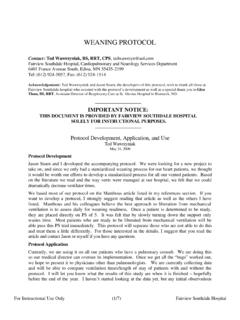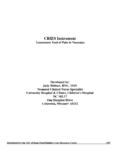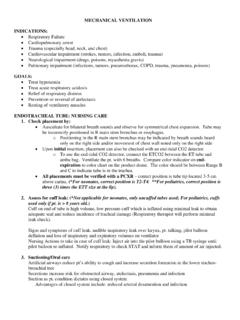Transcription of Evidence-Based Ventilator Weaning and …
1 Evidence-Based Ventilator Weaning and DiscontinuationNeil R MacIntyre MD FAARCI ntroductionAssessing Ventilator - discontinuation PotentialExtubationManaging the Patient Who Fails SBTP rotocols Implemented by Nonphysician CliniciansThe Role of Long-Term FacilitiesSummaryVentilator management of a patient who is recovering from acute respiratory failure must balancecompeting objectives. Discontinuing mechanical ventilation and removing the artificial airway as soonas possible reduces the risk of Ventilator -induced lung injury, nosocomial pneumonia, airway traumafrom the endotracheal tube, and unnecessary sedation, but premature Ventilator - discontinuation orextubation can cause ventilatory muscle fatigue, gas exchange failure, and loss of airway protection.
2 In1999 the McMaster University Outcomes Research Unit conducted a comprehensive evidence-basedreview of the literature on Ventilator - discontinuation . Using that literature review, the American Collegeof Chest Physicians, the Society of Critical Care Medicine, and the American Association for Respira-tory Care created Evidence-Based guidelines, which include the following principles: 1. Frequent assess-ment is required to determine whether ventilatory support and the artificial airway are still needed. who continue to require support should be continually re-evaluated to assure that all factorscontributing to Ventilator dependence are addressed.
3 3. With patients who continue to require support,the support strategy should maximize patient comfort and provide muscle unloading. 4. Patients whorequire prolonged ventilatory support beyond the intensive care unit should go to specialized facilitiesthat can provide more gradual support reduction strategies. 5. Ventilator - discontinuation and weaningprotocols can be effectively carried out by nonphysician words: mechanical ventilation, Weaning , practice guidelines, Evidence-Based medicine.[Respir Care 2004;49(7):830 836. 2004 DaedalusEnterprises]IntroductionPatients are generally intubated and placed on positive-pressure ventilation when their own ventilatory capabili-ties are outstripped by the ventilation demands imposed bydisease or when the respiratory drive cannot initiate ven-tilatory activity, because of disease or drugs (Fig.)
4 1). Asthe imbalance between ventilatory capability and ventila-tory demand begins to resolve, the clinical focus shifts toremoving the Ventilator as quickly as possible. Unneces-sary delay in withdrawing mechanical ventilation increasesthe likelihood of complications such as pneumonia, dis-comfort, and Ventilator -induced lung injury, and increasescost. However, the value of removing the Ventilator assoon as possible must be balanced against the risks ofpremature withdrawal, which include difficulty in re-establishing an artificial airway, ventilatory muscle fatigue,and compromised gas exchange.
5 Esteban et al estimatedNeil R MacIntyre MD FAARC is affiliated with Respiratory Care Ser-vices, Duke University Medical Center, Durham, North R MacIntyre MD FAARC presented a version of this report at the19th Annual New Horizons Symposium at the 49th International Respi-ratory Congress, held December 8 11, 2003, in Las Vegas, : Neil R MacIntyre MD FAARC, Respiratory Care Ser-vices, Room 7451, PO Box 3911, Duke University Medical Center,Durham NC 27710. E-mail: JULY2004 VOL49 NO7that as much as 42% of the time a medical patient spendson a mechanical Ventilator is during the withdrawal pro-cess1and that percentage is likely to be much higher witha patient who has a more slowly resolving lung are 4 main issues in the management of a me-chanically ventilated patient whose disease process hasbegun to stabilize and/or reverse.
6 First, it is necessary tounderstand all the reasons the patient continues to requiremechanical ventilation (eg, abnormal respiratory systemmechanics, gas exchange, neuromuscular dysfunction,and/or cardiac compromise). Continued treatment of all ofthe identified reasons is obviously integral to any ventila-tor discontinuation strategy. Second, the clinician needs touse assessment techniques to identify whether the patientcan tolerate Ventilator withdrawal. Third, if the patientcontinues to require ventilatory support, the appropriateventilator management strategies must be , with a patient who most likely will remain perma-nently Ventilator -dependent, an extended management planis 1999 the United States Agency for Healthcare Policyand Research (AHCPR)
7 Tasked the McMaster UniversityOutcomes Research Unit to do a comprehensive Evidence-Based review of the literature on Ventilator , in 2000, the American College of ChestPhysicians, the Society of Critical Care Medicine, and theAmerican Association for Respiratory Care formed a taskforce to utilize the AHCPR/McMaster report as well astheir own literature review to develop Evidence-Based rec-ommendations on Ventilator management of patients whorequire ventilation for 24 present report sum-marizes the most important of those recommendations (Ta-ble 1).Assessing Ventilator - discontinuation PotentialThe process of discontinuing mechanical ventilatory sup-port begins with the recognition that the patient has begunto recover from the problems that necessitated ventilatorysupport.
8 Thereafter careful clinical assessments are requiredto determine whether the patient is ready for reduction ofand then removal of ventilatory support and, then, extu-bation. However, the criteria by which clinicians decidewhether the patient has recovered enough to tolerate with-drawal of ventilatory support have not been clearly de-fined nor prospectively evaluated in a randomized con-trolled trial. Instead, various combinations of subjectiveand objective assessment criteria (eg, assessment of gasexchange, mental status, cardiovascular function, neuro-muscular function, and radiographic data) that may besurrogate markers of recovery have been employed (seeTable 1, recommendation 1).
9 4 10 Note that some patientswho never meet one or more of the suggested Ventilator - discontinuation criteria are, nevertheless, eventually liber-ated from the of the factors that initially required me-chanical ventilation is not enough to make a discontinua-tion decision. For example, one survey of intensivists us-ing clinical assessments alone for discontinuation potentialfound a sensitivity of only 35% (6 out of 17 who weanedwere identified) and a specificity of 79% (11 out of 14who failed to wean were identified).12 Moreover, in 2 largetrials,4,5despite apparent disease stability/reversal, the man-aging clinicians did not recognize prior to performing aspontaneous breathing trial (SBT) that discontinuation wasfeasible in almost two thirds of the subjects.
10 The conclu-sion is thus that some evidence of clinical stability/reversalis a key first step in assessing discontinuation potential butthat more focused assessments are needed before decidingto continue or discontinue ventilatory assessments done either while the patient isreceiving substantial ventilatory support (eg, minute ven-tilation requirement) or during a brief period of spon-taneous breathing (eg, vital capacity, negative inspira-tory force, work of breathing, ratio of respiratoryfrequency to tidal volume [f/VT]) can yield importantinformation about discontinuation ,integrated assessments done during a longer and care-fully monitored SBT provide the most useful informa-tion to guide the discontinuation decision (see Table 1,recommendation 2).
